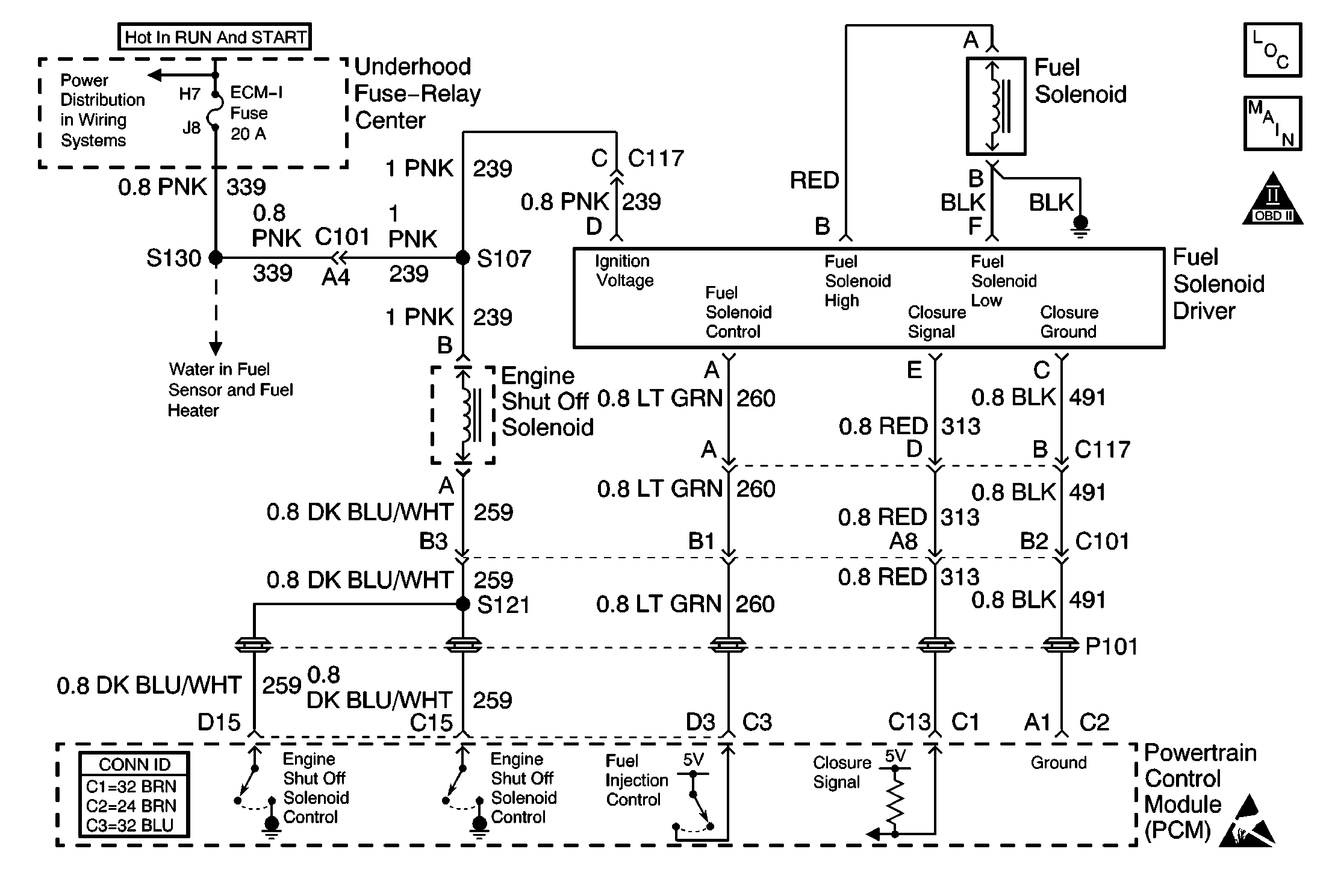
Circuit Description
The injection pump delivers the fuel to the individual cylinders by opening and closing a solenoid control fuel valve. The powertrain control module (PCM) monitors the amount of time it takes for the fuel solenoid valve to physically close after commanded to close. The closure time out of range is seen as a fault. This response time is measured in milliseconds.
Conditions for Running the DTC
| • | The battery voltage is greater than 10 volts and less than 16 volts. |
| • | The engine coolant temperature is greater than -1°C (34°F). |
| • | The engine speed is greater than 506 RPM. |
| • | The requested fuel rate is greater than 0.0 mm. |
Conditions for Setting the DTC
The Inj. Pump Closure Time is less than 0.75 ms.
Action Taken When the DTC Sets
| • | The PCM will not illuminate the malfunction indicator lamp (MIL). |
| • | The PCM records the operating conditions at the time the diagnostic fails. This information is stored in the Failure Records. |
Conditions for Clearing the MIL/DTC
| • | A history DTC clears after 40 consecutive warm-up cycles, if this or any other emission related diagnostic does not report any failures. |
| • | The scan tool Clear Info function was used. |
Diagnostic Aids
Intermittent DTCs (P0251, P0370 and P1216) may be caused by air entering the fuel system when fuel levels get below 1/8 of a tank while performing hard acceleration or turning maneuvers. Its also possible that a DTC P0251, P0370 and P1216 will set if vehicle has run out of fuel. Customer driving habits should be checked to determine if vehicle has been performing in these manners. If it has been determine that the vehicle has been performing in these conditions, bleed fuel system of all air and test drive vehicle.
If DTC P1216 is set with any of the other DTCs, diagnose those DTCs first. If the vehicle is running close to the DTC setting closure time, the vehicle should be checked during the cold start ups and during hot conditions.
An intermittent may be caused by the following:
| • | Poor connections |
| • | Rubbed through wire insulation |
| • | Broken wire inside the insulation |
Test Description
The numbers below refer to the step numbers on the diagnostic table.
-
This step determines if the ground circuit is open which causes the vehicle not to start.
-
This step determines if the signal circuit is open or an injection pump (fuel solenoid) is malfunctioning.
-
This step ensures that the replacement PCM, which utilizes an electrically erasable programmable read only memory (EEPROM), is programmed when installed.
Step | Action | Values | Yes | No | ||||||
|---|---|---|---|---|---|---|---|---|---|---|
1 |
Important: Before clearing the DTCs, use the scan tool Capture Info to save the Freeze Frame and Failure Records for reference. The data in the control module is deleted once the Clear Info function is used. Did you perform the Powertrain On-Board Diagnostic (OBD) System Check? | -- | ||||||||
Is the DTC P0219 also set? | -- | |||||||||
Does the engine start? | -- | |||||||||
4 |
Is the scan tool display less than or equal to the specified value? | 0.75 ms | ||||||||
5 | With the engine running, again observe the Inj. Pump Sol. Closure Time on the scan tool. Is the Inj. Pump Closure Time display less than or equal to the specified value? | 0.1 ms | ||||||||
6 | The DTC is intermittent. If no additional DTCs are stored, refer to Diagnostic Aids. If any additional DTCs are stored, refer to the applicable DTC tables first. Are there any additional DTCs stored? | -- | Go to the applicable DTC table | -- | ||||||
7 |
Did you perform a repair? | -- | ||||||||
8 |
Did you perform a repair? | -- | ||||||||
9 | Check the closure signal circuit for a poor connection at the PCM and replace the terminal if necessary. Refer to Wiring Repairs in Wiring Systems. Did you perform a repair? | -- | ||||||||
10 |
Important: The new injection pump must be timed. Refer to Fuel Injection Pump Timing Adjustment . Replace the fuel injection pump. Refer to Fuel Injection Pump Replacement . Is the action complete? | -- | -- | |||||||
|
Important: The new PCM must be programmed. Replace the PCM. Refer to Powertrain Control Module Replacement/Programming . Is the action complete? | -- | |||||||||
12 |
Does the scan tool indicate the diagnostic Passed? | -- | ||||||||
13 | Does the scan tool display any additional undiagnosed DTCs? | -- | Go to the applicable DTC table | System OK |
